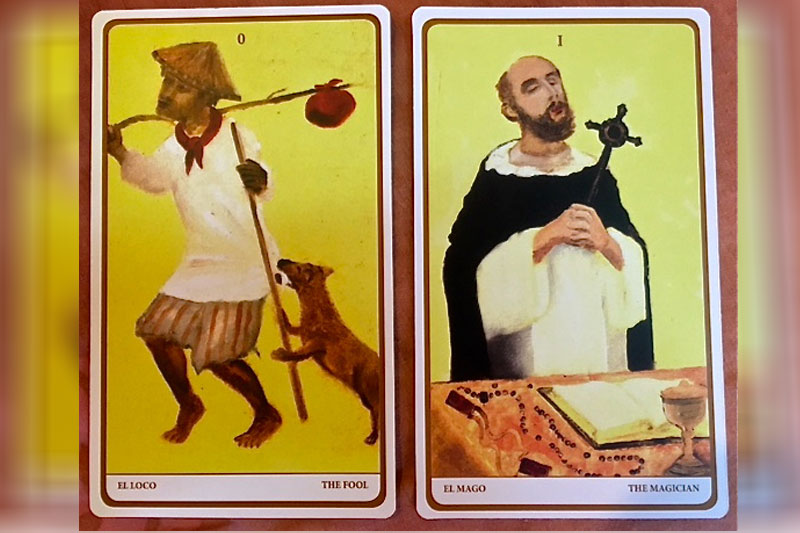The Filipinized tarot

Tarot cards.jpg — The first two cards of the Major Arcana
Way back in 1970 when some UP buddies and I set up Café Hurrimanna on the wrong side of Taft Avenue, I had a painting done as part of its décor: a copy of the Tarot card The Fool, from what was called the Original Waite Tarot deck, which had become the most popular set since it was released in 1910.
This deck, the bestselling among flower children of the ’60s/’70s, was also called the Rider-Waite-Smith deck. It was published by the Rider Company, with the images illustrated by artist Pamela Colman Smith upon the instruction of Arthur Edward Waite.
The Fool was the first or the most mystifying among the Major Arcana of 22 cards. As the Zero card, it preceded Number One which was The Magician. Depicted was a colorfully garbed fellow holding up a white flower in his left hand, while his right had a stick that rested on a shoulder, at the end of which was a small bag that presumably contained meager belongings. A dog nipped at the wanderer’s heels as he heedlessly steps forward from the edge of a cliff.
The enlarged replica — acrylic on plyboard — was hung on a wall of our café, perhaps as a reminder to all of us college-boy incorporators that it was a fool scheme we had embarked upon. True enough, while the café that featured weekend folk singers from Diliman and nightly Tarot readings by resident poet Eman Lacaba — billed as Mago Eman — became popular as a bohemian hangout for the first few months, it folded up in less than a year.
I brought The Fool home, to a small “pad” in Malate, and it stayed with me for years. I can’t remember how, why or when I lost possession of that piece or art.
Meanwhile, like Eman, whose surname we jokingly assigned provenance to the Qabbalah, I learned to rely on Tarot divination, along with the I Ching with its hexagram coins, for counsel on whether it was a good day to go to a wet market or sign a contract that might bind me to political patronage.
Down the years, I acquired various other Tarot editions, with the half-a-dozen boxed decks lying on my bedside to assure personal affinity. But like religion, or any occultist fad that waned with the passing of time, except for astrology, somehow I’ve distanced myself from these esoteric fancies that put a premium on faith.
In the 1980s, the outstanding graphic artist Brenda Fajardo came up with her Tarot series, which she would revisit time and again. In 2005 she had her last edition of these exhibits, billed as Baraha ng Buhay Pilipino: Major Arcana III (Cards of life: Major Arcana III). She is said to have “indigenized the Tarot images to convey a narrative of socio-political and colonial struggles in the Philippines.”
Trust the Filipino artist to draw from universal wellsprings of mysticism or esoteric lore as a source of inspiration and creativity, especially in advancing Pinoy consciousness towards all crossroads of cultural assimilation.
Now comes scholar, historian, lawyer and writer Saul Hofileña, Jr. with his version of the Filipino Tarot: an actual deck of the Major Arcana as “the only playable Tarot cards with Philippine themes,” together with a book that explicates and extrapolates so learnedly on the choice of images created in collaboration with Los Angeles-based artist Guy Custodio — who has had sold-out exhibits in Manila and assisted in the restoration of heritage churches in Bohol.
Hofileña’s book (and deck) is titled Cartas Philippinenesis, copyrighted in 2016. I was fortunate to receive it as a Christmas gift, but remain in the dark as to its availability.
Since only the first 22 Major Arcana cards are represented, absent the 56 Minor Arcana cards of four suits, this deck doesn’t quite provide for the full conduct of divination. Only a much simpler version involving three questions can be “played out.”
But the wealth of historical details that Holifeña shares spells total delight. The images he had Custodio create fall back on our colonial Christianization experience. In her preface, Maria Cristina Barron Soto of Mexico writes: “The cards are glimpses of the syncretism of the Catholic faith which when fused with the forces of nature, enrich and balance what is sacred to the Filipino people and bring to the fore a Spanish identity rooted in Christian tradition.”
Not that Hofileña accepts this tradition entirely; far from it. In fact the subversion of this faith, and our historical fate as a subjugated people, is carried out most subtly. His intellectual wink is as valuable as the asides in the informative text, as much as his choices for pictorial inclusion.
While an indifferent indio peasant is El Loco, the Spanish friar is El Mago. La Sacerdotisa (The High Priestess) recalls the babaylan, now turned beata. La Emperatriz is the Blessed Virgin Mary, “the undisputed queen of the Philippines.” Portrayed as El Emperador, holding up a scroll, is Spanish Governor-General Narciso Claveria, who in the 1840s mandated the Catalogo de Apellidos or new surnames for all indios — “with the list that would forever change the Filipino’s personal history.”
Pictorial backgrounding includes churches, a watchtower and belfry of Bohol, a cemetery arch in Iloilo, a Cavite fort, and the Carriedo Fountain in Manila. The 19-year-old Rizal is quoted, as are European personages. The Puhalan movement in Samar is recalled, while bishops, archbishops and the friar orders are paraded anecdotally.
Lack of space prohibits us from further extolling the breadth of scholarship and uncanny historical interpretations that make this set (both deck and book) a treasure of delight. But it is; they are. Hofileña and Custodio add a jewel to Filipiniana.



















